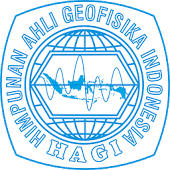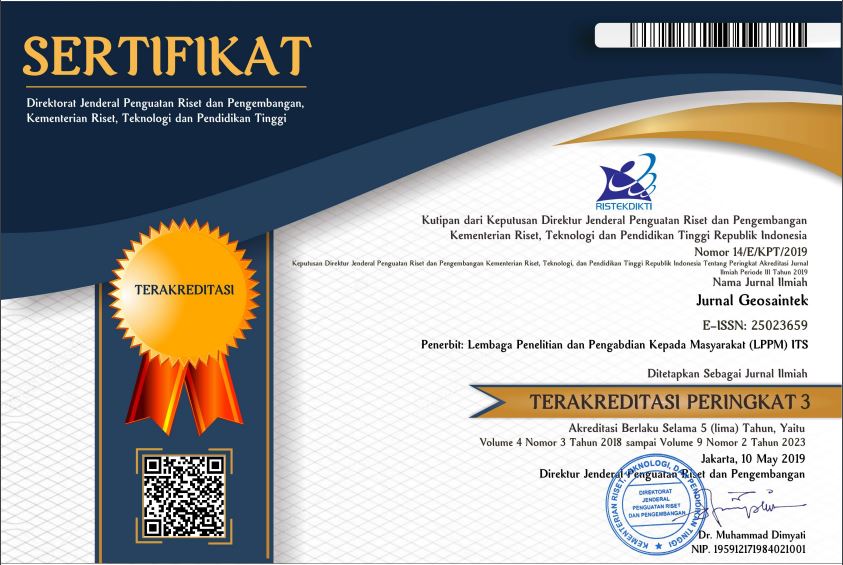APLIKASI METODE SEISMIK REFRAKSI DAN MASW UNTUK LINTASAN TEROWONGAN. STUDI KASUS : WILAYAH “SMBR”
Abstract
Metode seismik refraksi telah banyak digunakan untuk rekayasa bawah permukaan dalam mengidentifikasi struktur dan stratigrafi dengan memanfaatkan perbedaan elastic properties pada batuan. Pada penelitian seismik refraksi diterapkan untuk analisa bawah permukaan dalam penentuan jalur terowongan. Terowongan yang direncanakan melewati perbukitan di wilayah SMBR sangat penuh dengan resiko geologi seperti adanya struktur dan zona weathering layer. Panjang lintasan akuisisi ini sepanjang 1800 m dengan 38 titik tembak. Dari hasil pengolahan data diperoleh 3 buah lapisan, Lapisan pertama adalah soil atau tanah residual dengan rentang velocity 300-1200 m/s, pada lapisan kedua terdapat sandstone dengan rentang nilai velocity 1800 – 3100 m/s dan pada lapisan ketiga terdapat lapisan siltstone dengan rentang 2400-4400 m/s. Selain itu terdapat struktur berupa patahan pada meter ke-1105. Berdasarkan data bor sampai kedalaman 50 m dominan terdapat sandstone sehingga sering terjadi lose. Dengan mengetahui kondisi bawah permukaan diharapkan proses konstruksi menjadi lebih efektif dan menurunkan risiko kecelakaan kerja.
=====================================================
Seismic refraction methods have been widely used to analyze some of the elastic properties of rocks. In this study, improvements were made to the subsurface analysis in determining the tunnel path. The tunnel that is separated in the hills in the area of SMBR is very complete with geological risks as well as zone structure and weathering layers. The length of this line is 1800 m long with 38 shoot points. From the data processing obtained 3 layers, the first layer is the ground or residual soil with a velocity of around 300-1200 m / s, in the second layer there is sandstone with an average velocity range 1800 - 3100 m / s and on the layer of soil there is a layer siltstone with range 2400-4400 m / sec. In addition there is a fracture structure on 1105. Based on borehole data with a depth of 50 m dominant there is sandstone, often a loss. By knowing the subsurface condition is expected to make the construction process more effective and reduce the risk of work accident.
Keywords
: Seismik Refraksi; Terowongan; Velocity Layer
References
Barton, N. (2007), Rock quality, seismic velocity, attenuation and anisotropy, CRC press.
Hai-hong, D. dan Wei-wei, J. (2016), Application of Geophysical Methods in Tunnel Exploration,.
Jurić-Kaćunić, D., Arapov, I. dan Kovačević, M.S. (2011), "New approach to the determination of stiffness of carbonate rocks in Croatian karst", Grad jevinar, Vol.63, No.02., hal. 177–185.
Menzies, B.K., Saxena, K.R. dan Sharma, V.M. (2000), "Near-surface site characterisation by ground stiffness profiling using surface wave geophysics", dalam Instrumentation in Geotechnical Engineering, Oxford & IBH Publishing Co. Pvt. Ltd, hal. 43–71.
Nurdiyanto, B., Hartanto, E., Ngadmanto, D., Sunardi, B. dan Susilanto, P. (2011), "PENENTUAN TINGKAT KEKERASAN BATUAN MENGGUNAKAN METODE SEISMIK REFRAKSI", Jurnal Meteorologi dan Geofisika, Vol.12, No.3. Diambil dari http://202.90.199.54/jmg/index.php/jmg/article/view/103.
Zond (2016), "Inversion", dalam Program of two-dimensional seismic data processing and interpretation (surface, borehole and marine variations) Module: correlation method of refracted waves - layered medium, MASW, amplitude inversion, anisotropy, Zond Geophysical Softtware, hal. 60–63
DOI: http://dx.doi.org/10.12962%2Fj25023659.v1i1.3993
Refbacks
- There are currently no refbacks.

Jurnal Geosaintek diterbitkan oleh ITS bekerja sama dengan Himpunan Ahli Geofisika Indonesia (HAGI)
Disebarluaskan di bawah Lisensi Creative Commons Atribusi-BerbagiSerupa 4.0 Internasional.
Berdasarkan ciptaan pada https://iptek.its.ac.id/index.php/geosaintek/index.





